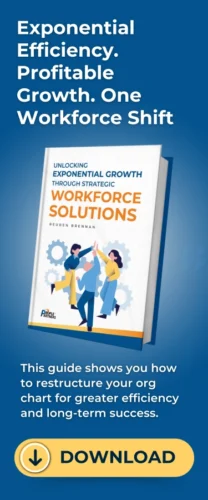What if the secret to sustainable business growth isn’t hiring more people, but getting smarter about the roles they play within the workforce and going beyond job titles?
That’s the challenge Reuben Brennan, CEO of PeoplePartners, is putting to forward-thinking business leaders.
In an era marked by economic uncertainty, talent shortages, and rising labor costs, simply adding more headcount is no longer a viable growth strategy. Instead, Reuben advocates for a smarter approach: re-engineering roles to boost productivity, align people with tasks they excel at, and leverage offshore and AI support in targeted, thoughtful ways.
This isn’t about cutting corners. It’s about creating scalable structures that empower people to do their best work and help businesses grow without unnecessary complexity.
Here’s how that works in practice.
Move Beyond Job Titles. Start Thinking in Outcomes.
Too often, workforce planning becomes a game of duplication. More clients? Hire another account manager. More students? Add a second trainer. This default mindset leads to bloated teams, rising costs, and overworked employees.
Reuben urges leaders to take a step back:
“Leadership teams need to stop automatically thinking about duplicating roles when they’re considering headcounts. It makes more sense to segment out some responsibilities so that we scale by having more refined, tighter position descriptions.”

Instead of scaling your org chart vertically, zoom out and ask:
- • What outcomes are we trying to deliver?
- • Where are we constrained?
- • Could we restructure existing roles to get more capacity without more cost?
This shift from hiring based on job titles to designing around outcomes and capacity is foundational to reimagining your workforce for today’s needs.
Unpack the Role. Unleash the Potential.

Every role is really a bundle of tasks. But not all tasks belong together.
Reuben shares a common example: a company hiring for an accounts receivable clerk who is expected to both reconcile financial records and make outbound debt collection calls.
“Those are two very different personality styles. One requires high attention to detail, the other thrives in high-stakes interpersonal conversations.”
Trying to find someone who excels at both is often unrealistic. Instead, Reuben advises businesses to interrogate the position description:
- • Do the grouped tasks demand compatible skill sets?
- • Could some of the work be reassigned to someone better suited?
- • Would that unlock greater efficiency, performance, and satisfaction?
When roles are designed around alignment, putting people in their passion zones, the ripple effect is powerful. People are more engaged, retention improves, and performance naturally follows. Smart businesses understand this and use it as a lever for sustainable growth.
Offshore Talent Isn’t All or Nothing

Rethinking partial offshoring as a strategic unlock
A major barrier to innovation is the false belief that roles must be either entirely onshore or entirely offshore.
“It’s not a binary decision. Maybe 10 percent, 20 percent, even 80 percent of a role’s tasks can be done offshore. We need to challenge the idea that unless everything can be outsourced, nothing should be.”
In healthcare and education, for instance, a physiotherapist or trainer must meet patients or students locally. But that doesn’t mean they have to handle scheduling, diary management, reporting, or follow-ups.
“You don’t need more physiotherapists. You get more capacity out of the ones you already have by offloading admin work.”
This principle isn’t theoretical. PeoplePartners worked with a regional training provider that struggled to meet student demand due to a limited number of trainers. By delegating non-teaching tasks to offshore training assistants, each trainer was able to increase their student load from 65 to 100 without compromising quality.
Offshoring isn’t just about cost savings. It’s about building capacity and making better use of the talent you already have.
How Do You Know When a Role Needs Re-Engineering?

You don’t need a major crisis to justify re-engineering a role. Even jobs that look fine on paper can be quietly breaking down under pressure.
Here are the telltale signs:
- • Burnout or overtime: Are employees stretched too thin?
- • High turnover: Are expectations misaligned with reality?
- • Long onboarding: Does it take months to train new hires?
“Often, we just keep adding things to a role without taking anything away. Over time, it gets bigger and bigger. It needs pruning,” Reuben explained.
To fix this, start by examining the tasks:
- • Are they done inside (on a computer) or outside (in the field)?
- • Are they interpersonal or analytical?
- • Do they align with the same working style or require different strengths?
Many overloaded roles turn out to be two or three jobs disguised as one. Once those responsibilities are separated, you regain control, unlock performance, and reduce churn.
The Hidden Power of AI Plus Offshore
AI-enhanced teams outperform talent-only models
AI is not a threat to your workforce. It’s a multiplier—but only if your people know how to use it.
“Even if it starts with basic ChatGPT training, it’s about using AI as a thought partner, not just to generate content but to think more critically and work more efficiently,” Reuben shared.
At PeoplePartners, smart businesses benefit as offshore team members are trained in AI fundamentals and encouraged to share prompts, tools, and tips through dedicated collaboration channels. This creates a culture of ongoing learning and innovation.
The results speak for themselves. When AI-enhanced staff are paired with re-engineered roles and offshoring strategy, companies achieve:
- • Up to 70 percent labour savings
- • Two to three times greater productivity
- • Less burnout among onshore employees
It’s not just smarter; it’s scalable, sustainable growth.
Smart Growth Means Thinking Differently

Why do some companies stay stuck while others adapt?
Reuben says it’s not always about vision or planning.
“Often, the businesses that change aren’t the most strategic. They’re the ones with their backs against the wall.”
Smart businesses don’t wait for a crisis. They begin with small, strategic steps.
Pick one overloaded or misaligned role. Dissect it. Rethink it. Redesign it.
“Once you see that some of these tasks don’t belong together, it’s hard to unsee it.”
That first shift often opens the floodgates. Leaders discover hidden capacity, staff feel more supported, and the whole business moves faster with less friction.
Leadership’s New Mandate: Own the Structure

Re-engineering isn’t just an operational decision. It’s a strategic responsibility.
“I think what changes when someone starts thinking about outcomes and capacity instead of just job titles is that they break free from the limits of the existing org chart,” Reuben shared.
When leaders stop clinging to how things have always been done, they open the door to how things could be done better.
This is where real transformation happens. Not in titles, but in task design. Not in headcount, but in value creation.
It’s how high-growth companies stay agile while others fall behind.
Unlearn the All-or-Nothing Mentality
Reuben admits he made the same mistake early on: assuming roles had to stay entirely onshore if even one task required it.
But that thinking didn’t hold up.
“It’s not a case of all or nothing. There can be all manners of 10%, 20%, 80% of tasks and responsibilities on any given role that could be done offshore. And if we look through that lens… we could be seeing hundreds of thousands, if not millions of dollars in labour savings.”
Rethinking workforce design isn’t about replacement. It’s about optimisation. Smart businesses focus on freeing up their best people to do what they love and do best, while enabling the company to scale with less waste, less burnout, and a lot more clarity.
Ready to Go Beyond Job Titles?
The most scalable companies of the future won’t be the ones with the most employees. They’ll be the ones who know how to:
- • Design lean, aligned roles
- • Segment tasks by value and complexity
- • Use offshore talent and AI wisely
- • Focus on outcomes, not job titles
Contact us to explore how Workforce Re-Engineering can unlock efficiency and momentum in your business without hiring your way into chaos.

